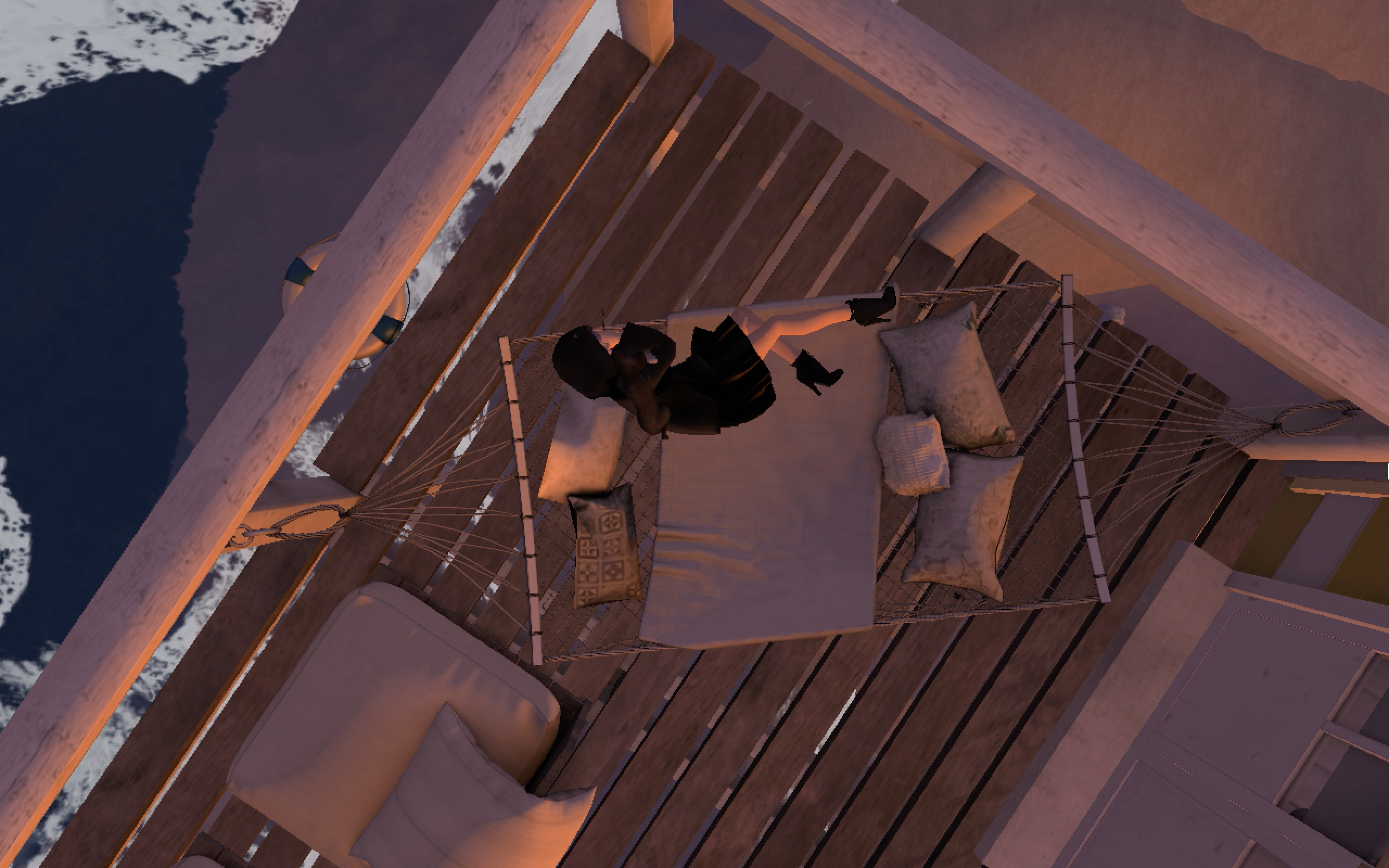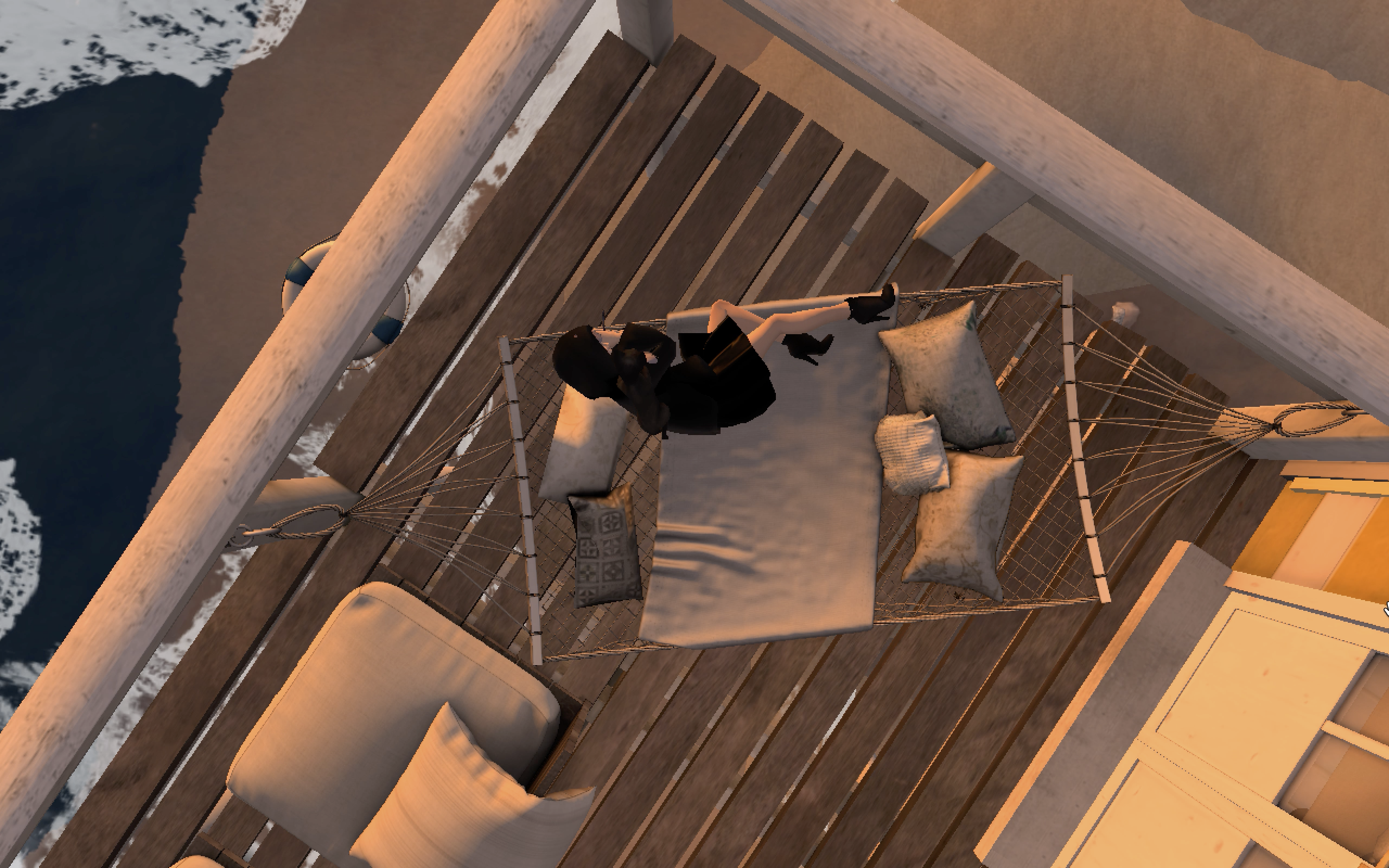Technical Difficulties
For my machinima project, I chose the more popular method of video capture rather than computer programming directly in the virtual world. I recorded all of my video footage via the screen capturing system, Quicktime Player. Although I didn’t have to carry heavy film equipment or spend money, I had technical difficulties with the process of capturing the image. One of my biggest problems was lag time. Whenever I started recording, the movement in the game would slow down and drag. The worst case is when each frame is stretched out in time, like a string of photos, rather than a coherent, continuously movement. My computer would get extremely hot, and I knew that the computer couldn’t process two applications—moving in the virtual world and screen capturing—at the same time, for a long period of time. This problem occurred throughout the scene I tried to film below.
I was riding on a bike, and every frame would freeze for at least two to three seconds. At this time, my computer was really hot and blowing out angry wind. I wanted to stop the video capture, but my computer was still trying to carry out the virtual world movements that I commanded on my keyboard a few seconds before. This lag time accumulated, until my image froze all together. I had to wait about three minutes before my computer caught up with all of my commands, and I also ended up not being able to use the footage.
This situation is ironic considering that it reminded me of the very roots of cinema as “motion-pictures,” that each frozen picture was supposed to be a quick image that flashes before my eyes to create the illusion that movement was coherent and smooth, not breakable into individual units. Thus, machinima brought me back to a logical, basic understanding of the technicality of film, while also offering new insight into digital filmmaking with the absence of physical film equipment.
Camera Control
It took me a while to know all of the control keys for viewing the virtual space, but once I started getting the hang of it, it came naturally to me. Unlike in the real world, where I can look directly at the actor standing in front of me or choose to look at the camera screen of the actor in the diegetic world, these two options are merged into one in the virtual world. I can only see what I am filming, and I can only film what I see. In a sense, it actually saves me effort, but I would need to actually try out the camera movement in order to see if such movement will do.
One of my main problems with camera control is that I couldn’t get slow, smooth shots. Everything was spontaneous, and whenever I pressed down on a command key to, say, pan my camera to the left, the image would shift quickly to the left, instead of slowly and steadily moving to the left as desired. I had no control over this because I don’t want to spend money on buying a screen capturing software, which may increase my image lag time and slow down my shooting frame-rate beyond compare. I decided to film however my command keys maneuvered the image, and then slightly edited the speed of the image in post-production, via Final Cut Pro. It was especially difficult to resolve some of the lag time issues even in post-production, so I had to discard some of the shots.
For every new virtual space that I enter, I spend at least 10 minutes in each one, exploring the location, objects, places to sit, decorations, etc. I then usually video capture in the space for 1 to 3 minutes, moving my camera in many different angles and directions, and then choosing the ones I like best in post-production. Thus, most of the images and camera movements in the shot are discarded.
Sound
One of the biggest problems with filming in the virtual world is you essentially have to create every sound you need. That is why most of the machinimas I found on YouTube were covered with music and no dialogue, since dubbing does not always sound on point. I initially chose to follow the same path, but considering that I didn’t want my machinima to feel too abstract, I added a short narrative, which was recorded separately on my iPhone and later edited into the film, to give the image context (substance perhaps?) and a sense of a storyline; however I did not entirely want to take away the abstract, symbolic nature of the diegesis, which in itself is abstract to us on a digital level as intangible to the hand, yet tangible to the eye.
Mise-en-scène
Similar to making films in the real world, I had to choose set locations. Different from filming in the real world, I personally couldn’t set up the location because it’s already created by other players, and I didn’t have time to make objects and set them up, considering I may just use available resources. For example, in the image below, I was originally going to have my character sleep in this room, but I ended up entering the beach house server, and found a more suitable room, so I ended up discarding everything I filmed in this space.
One of the advantages of filming in the virtual world is that I may control lighting and weather. I mainly changed time of day, because I liked the feeling that the colors of the sunrise and sunset created, which was uniform for each space I entered, while each space also had its own set control weather. In the film, you see two instances where I specifically applied different weathers and lighting to suggest the passage of time.
The interesting thing is I adjusted the weather in the virtual world itself, which is different from applying a color filter in post production. The shadows cast on the objects can create different shades of color unattainable in post-production, thus this is one of the beautiful advantages of filming in the virtual world. Speaking of color correction, I ended up not using it in post-production because in virtual worlds, the color is already balanced, and would not overexpose. On the other hand, in the real world, we would need to adjust camera to its optimal settings.
All in all, machinima for me retained its cinematic quality, but given its special advantages lacking in real world film production, it is reasonable to characterize machinima, not merely as machine and cinema, but as a new media form. New media in itself does not entail the very basic form of cinema, and I believe this categorization for machinima is not misplaced. In the future, machinima will continue to change as an experimental art form!




